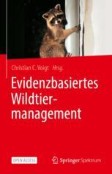Search
Search Results
-
Wie lassen sich Nutztierübergriffe durch Wölfe nachhaltig minimieren? – Eine Literaturübersicht mit Empfehlungen für Deutschland
Mit dem anwachsenden Wolfsbestand nehmen auch die Übergriffe auf Nutztiere in Deutschland von Jahr zu Jahr zu. In einem Punkt sind sich...
-
Carried away by a moonlight shadow: activity of wild boar in relation to nocturnal light intensity
An increase of nocturnal activity of ungulate species may represent a compensatory opportunity for energy intake, when activity in daylight is...

-
Biodiversity lost: The phylogenetic relationships of a complete mitochondrial DNA genome sequenced from the extinct wolf population of Sicily
Using next-generation sequencing, we obtained for the first time a complete mitochondrial DNA genome from a museum specimen of the extinct wolf (Canis...
-
A small neighborhood well-organized: seasonal and daily activity patterns of the community of large and mid-sized mammals around waterholes in the Gobi Desert, Mongolia
BackgroundAnimal communities have complex patterns of ecological segregation at different levels according to food resources, habitats, behavior, and...

-
The Socio-Ecology of Wolves
This short review summarizes aspects of the socio-ecology of wolves that might be relevant to understand dog-wolf differences in behaviour and...
-
Acoustic localization at large scales: a promising method for grey wolf monitoring
BackgroundThe grey wolf ( Canis lupus ) is naturally recolonizing its former habitats in Europe where it was extirpated during the previous two...

-
The canine counts! Significance of a craniodental measure to describe sexual dimorphism in canids: Golden jackals (Canis aureus) and African wolves (Canis lupaster)
Sexual dimorphism is a widespread phenomenon among mammals, including carnivorans. While sexual dimorphism in golden jackals ( Canis aureus ) has been...

-
Estimation of pack density in grey wolf (Canis lupus) by applying spatially explicit capture-recapture models to camera trap data supported by genetic monitoring
BackgroundDensity estimation is a key issue in wildlife management but is particularly challenging and labour-intensive for elusive species. Recently...

-
Sex-specific ventral dichromatism and melanization in harlequin toads (Atelopus): a common but overlooked character of unknown function
Hidden colors are a widespread phenomenon in the animal kingdom, particularly in anurans. In some cases, hidden colors are suddenly exposed during...

-
Dog colour patterns explained by modular promoters of ancient canid origin
Distinctive colour patterns in dogs are an integral component of canine diversity. Colour pattern differences are thought to have arisen from...

-
Functional ecological convergence between the thylacine and small prey-focused canids
BackgroundMorphological convergence is a fundamental aspect of evolution, allowing for inference of the biology and ecology of extinct species by...

-
Who’s Who in the Neighbourhood: Common Spiders in the Garden and its Surroundings
If you walk alongCommon forest wolf spider the edge of a forestWolf spider on a sunny spring dayLycosidae, you will see these 5–8 mm long, blackish...
-
Farley Mowat Never Cried Wolf
Canadian author Farley Mowat used his literary skills to promote conservation causes. In his most successful books ‘Never Cry Wolf’ and ‘A Whale for...
-
Co** styles in capital breeders modulate behavioural trade-offs in time allocation: assessing fine-scale activity budgets in lactating grey seals (Halichoerus grypus) using accelerometry and heart rate variability
AbstractBalancing time allocation among competing behaviours is an essential part of energy management for all animals. However, trade-offs in time...

-
Collection and characterization of grey mildew (Ramularia areola Atk.) pathogen of cotton
Grey mildew/false mildew of cotton caused by R. areola regarded as destructive on desi-cotton genotypes. Generally, causes premature defoliation of...

-
Crane Knowledge Compact: The Myths and the Facts
Back then, as I anxiously watched the crane pair in its confined breeding site, apparently controlled by their purely mechanical instincts, I knew...
-
Citizen science and diet analysis shed light on dog-wildlife interactions in Italy
Domestic dogs Canis familiaris may cause a range of impacts on wildlife through predation, competition, pathogen transmission, harassment and...

-
Assessing Asiatic black bear (Ursus thibetanus) temporal overlap and co-occurrence with sympatric species in the temperate zone of the Hindu Raj Mountain range
Ecological research focused on Asiatic black bears ( Ursus thibetanus ) sympatric interactions is critical for understanding not only species...

-
Nature Conservation is Quite Successful: The Example of Large Animal Species
Large animal species are particularly important to us. These have also been among the most successful of conservation efforts. In most cases, this...
-
Scent marking in wolves Canis lupus inhabiting managed lowland forests in Poland
In wolves Canis lupus , scent marking plays an important role in territory defence. In Europe, studies on patterns of scent marking in wolves have...

